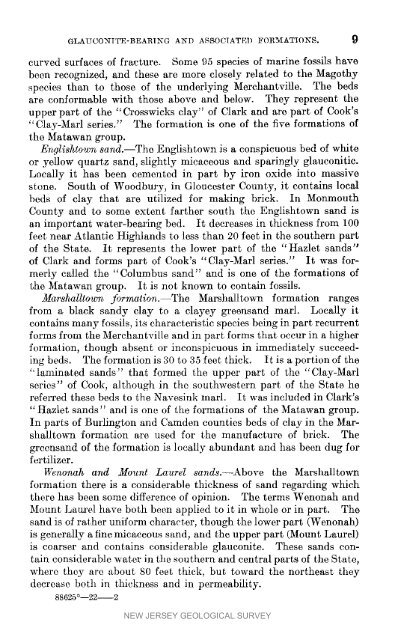Bulletin 23. Potash in the Greensands of NJ, 1923 - State of New ...
Bulletin 23. Potash in the Greensands of NJ, 1923 - State of New ...
Bulletin 23. Potash in the Greensands of NJ, 1923 - State of New ...
You also want an ePaper? Increase the reach of your titles
YUMPU automatically turns print PDFs into web optimized ePapers that Google loves.
GLAUCONITE*BEARING AxeD ASSOCIATED FORMATgO_TS. _}<br />
curved surfaces <strong>of</strong> fracture. Some 95 species <strong>of</strong> mar<strong>in</strong>e fossils have<br />
been recognized, and <strong>the</strong>se are more closely related to <strong>the</strong> Magothy<br />
species than to those <strong>of</strong> <strong>the</strong> underly<strong>in</strong>g Merchantville. The beds<br />
are conformable with those above and below. They represent <strong>the</strong><br />
upper part <strong>of</strong> <strong>the</strong> "CS"osswicks clay" <strong>of</strong> Clark and are part <strong>of</strong> Cook's<br />
"Clay-Marl series." The formation is one <strong>of</strong> <strong>the</strong> five formations <strong>of</strong><br />
<strong>the</strong> Matawan group.<br />
EnglishtowT_ sand.--The Englistltown is a conspicuous bed <strong>of</strong> white<br />
or yellow quartz sand, slightly mieaceous and spar<strong>in</strong>gly glauconitic.<br />
Locally it has been cemented <strong>in</strong> part by iron oxide <strong>in</strong>to massive<br />
stone. South <strong>of</strong> Woodbury, <strong>in</strong> Gloucester County, it conta<strong>in</strong>s local<br />
heds <strong>of</strong> clay that are utilized for mak<strong>in</strong>g brick. In Monmouth<br />
County and to some extent far<strong>the</strong>r south <strong>the</strong> Englishtown sand is<br />
an important water-bear<strong>in</strong>g bed. It decreases <strong>in</strong> thickness from 100<br />
feet near Atlantic Highlands to less than 20 feet <strong>in</strong> <strong>the</strong> sou<strong>the</strong>rn part<br />
<strong>of</strong> <strong>the</strong> <strong>State</strong>. It represents <strong>the</strong> lower part <strong>of</strong> <strong>the</strong> "Hazlet sands"<br />
<strong>of</strong> Clark and forms part <strong>of</strong> Cook's "Clay-Marl series." It was formerly<br />
called tile "Columbus sand" and is one <strong>of</strong> <strong>the</strong> formations <strong>of</strong><br />
5he Matawan group. It is not known to conta<strong>in</strong> fossils.<br />
Marshalltown formatio*l. The Marsha]Ito_m formation ranges<br />
from a black sandy clay to a clayey greensand marl. Locally it<br />
conta<strong>in</strong>s many fossils, its characteristic species be<strong>in</strong>g <strong>in</strong> part recurrent<br />
forms from <strong>the</strong> Merchantville and <strong>in</strong> part forms that occur <strong>in</strong> a higher<br />
formation, though absent or <strong>in</strong>conspicuous <strong>in</strong> immediately succeed<strong>in</strong>g<br />
beds. The formation is 30 to 35 feet thick. It is a portion <strong>of</strong> <strong>the</strong><br />
"lam<strong>in</strong>ated sands" that formed <strong>the</strong> upper part <strong>of</strong> <strong>the</strong> "Clay-Marl<br />
series" <strong>of</strong> Cook, although <strong>in</strong> <strong>the</strong> southwestern part <strong>of</strong> <strong>the</strong> <strong>State</strong> he<br />
referred <strong>the</strong>se beds to <strong>the</strong> Naves<strong>in</strong>k marl. It was <strong>in</strong>cluded <strong>in</strong> Clark's<br />
"Hazlet sands" and is one <strong>of</strong> <strong>the</strong> formations <strong>of</strong> <strong>the</strong> Matawan group.<br />
In parts <strong>of</strong> Burl<strong>in</strong>gton and Camden counties beds <strong>of</strong> clay <strong>in</strong> <strong>the</strong> Marshalltown<br />
formation are used for <strong>the</strong> manufacture <strong>of</strong> brick. The<br />
grcensand <strong>of</strong> <strong>the</strong> formation is locally abundant and has been dug fox'<br />
fertilizer.<br />
Wenonah and Mount Laurel sands.--Above <strong>the</strong> Marshalltown<br />
formation <strong>the</strong>re is a considerable thickness <strong>of</strong> sand regard<strong>in</strong>g which<br />
<strong>the</strong>re has been some difference <strong>of</strong> op<strong>in</strong>ion. The terms Wenonah and<br />
Mount Laurel have both been applied to it <strong>in</strong> whole or <strong>in</strong> part. The<br />
sand is <strong>of</strong> ra<strong>the</strong>r uniform character, though <strong>the</strong> lower part (Wenonah)<br />
is generally a f<strong>in</strong>e micaceous sand, and <strong>the</strong> upper part (Mount Laurel)<br />
is coarser and conta<strong>in</strong>s considerable glaucolfite. These sands conra<strong>in</strong><br />
considerable water <strong>in</strong> <strong>the</strong> sou<strong>the</strong>rn and central parts <strong>of</strong> <strong>the</strong> <strong>State</strong>,<br />
where <strong>the</strong>y are about 80 feet thick, but toward <strong>the</strong> nor<strong>the</strong>ast <strong>the</strong>y<br />
decrcasc both <strong>in</strong> thickness and <strong>in</strong> permeability.<br />
88625°--22--2<br />
NEW JERSEY GEOLOGICAL SURVEY

















